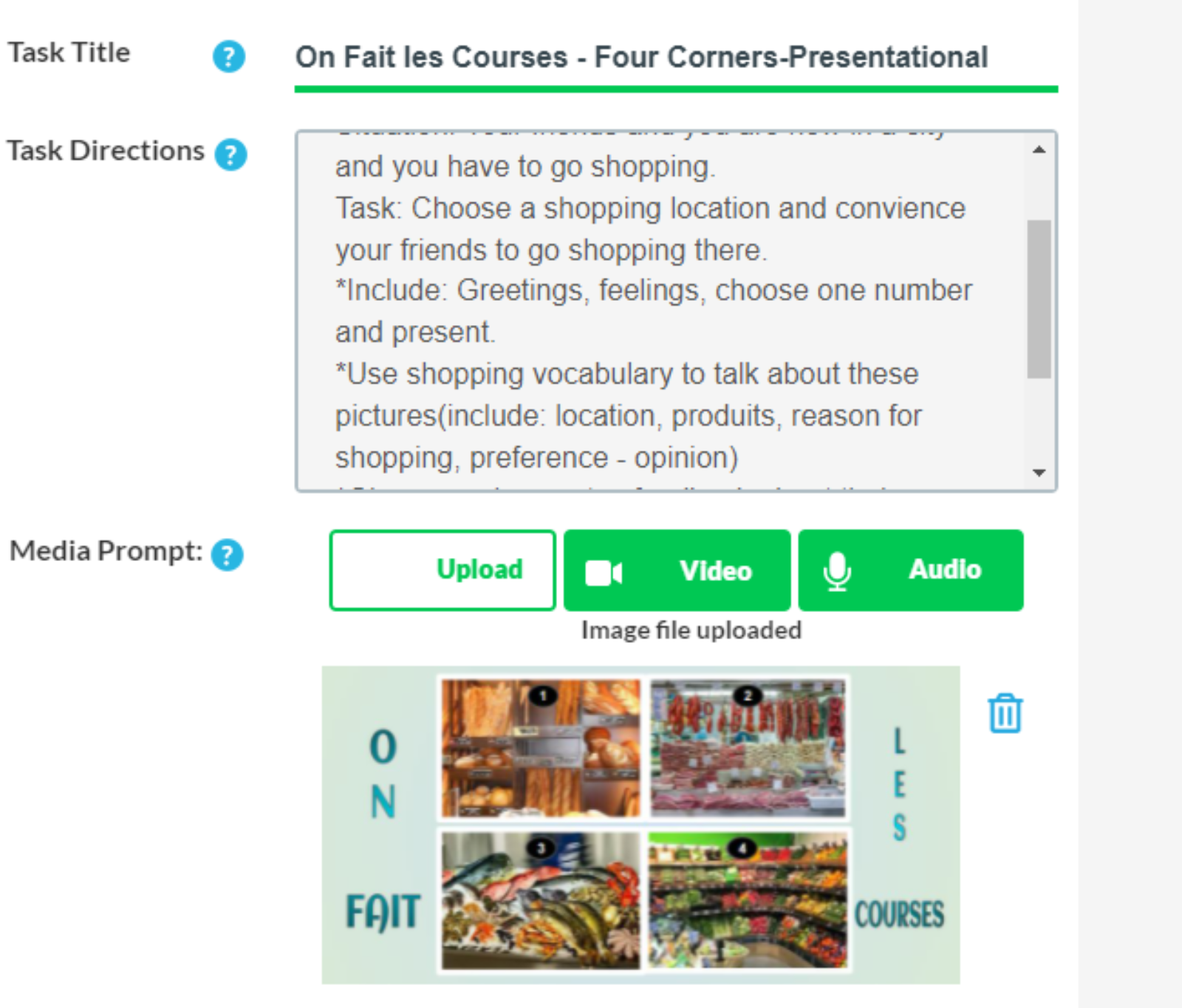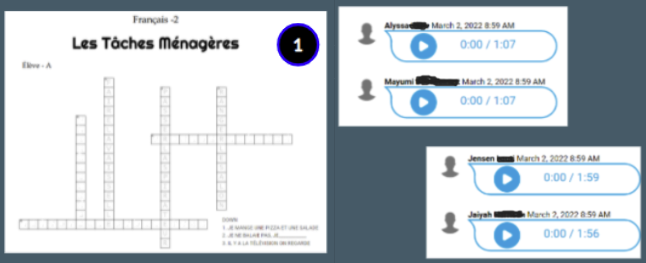
This post is written by one of our Extempore teacher Ambassadors, Dorah Fauben, who teaches French at Mayfair High School in Lakewood, California.
I always look forward to the beginning of the school to see who has chosen to be in my French class. Each time at the door, I greet students with ‘Bonjour et bienvenue au cours de français… Ici ON PARLE FRANÇAIS!’ This is either followed by complete silence or an outburst of ‘what!?’ As I respond with, ‘Aaah oui,' I reassure them: they have to listen, repeat, practice and then they can fly!
Parle! Parlons! Parlez! Encouraging my students to speak as much as they can during class is a leitmotif in my French class. It's helpful to explain to students the reasons for doing what we do in class. From day one, students learn that we are not here to study grammar and vocabulary lists, but to use these in context to be able to listen, speak, read and write French. This has been huge in helping students understand the process and acquisition of language. As I teach with comprehensible input, I love sharing this quote from Stephen Krashen about language acquisition with my students.
We acquire language when we understand what we hear and read, when we understand what people are saying to us, not how they say it.
Facilitating Learning With Communicative Tasks
No matter what thematic unit I teach, I focus on speaking tasks while addressing my students' oral output. We focus on speaking first because it is normally indicative of students' proficiency in the TL, especially beyond the classroom. Keeping in mind that not all students learn the same way, I make sure to provide accommodations (such as wait time, one-one-one speaking sessions) to students who are hesitant or shy when speaking in front of their classmates. In addition, students complete self-evaluations to identify concerns they have about the class and our assessments. The results often indicate which skills students need supplemental help on to best learn the TL.

In this next section, I will refer to Leslie Grahn’s chart guide above that shows the goal of creating communicative tasks.
When using authentic materials, I scaffold and provide multiple ways to practice the language. I had to create a system that provides structure to my learners and make them ready for #3 in the chart above. Here’s how it works:
- When students have mastered how to use any of the content, direct them to complete the tasks without leaning on the notes or handouts.
- Teach and introduce content in chunks.
- Make handouts available in various formats: hard copy, word walls, anchor charts, as well as digital and audio versions posted on your LMS.
Find some more strategies below of how I facilitate speaking tasks in my classroom.
Have a routine!
Mondays are short days at my school. I regularly implement speaking skills during teaching-learning moments. I like to implement the 10/2 (ten plus two strategy). I present content in chunks (reference: Marzano’s instructional framework) and give students a few minutes of activities (A-B partner, colored response etc) to check for understanding before I proceed. But my students already know that whatever is on the agenda on Mondays, there will always be SPEAKING, sometimes free practice and at other times, controlled. In addition, I do not introduce new content on Fridays; instead, I reserve this day for reviewing learned concepts, reteaching and SPEAKING tasks.
Use handouts / references!
This is a way to scaffold the content, and my students know that they have access to these tables all year… or as needed (the goal is to ween them off over time). All my levels, one through AP, have a Q&A handout (see images below) which we complete at the same time (the students write and I type), through questioning and discussions. Students may write suggested answers or their own answers. The Q&A handout is completed at the end of lesson or unit on a weekly basis. The level of questions vary from novice at level one to complex structures at higher levels. The table I created has subtitles (numbers, questions /answers/ topics / translation - all optional). I make copies and give out new pages to students as needed. By the end of the year, students have a collection of frequently asked questions/answers etc. See further below how students use these in controlled practice and communicative tasks.

Rejoinder wall / cards
What is language and communication without showing emotions, approval, disapproval, and encouragement? Blogs by both Grant Boulanger and Bryce Hedstrom are both great resources on using rejoinders. This year, I snipped the Bitmoji rejoinders from Allison Litten. My students use these in context alongside the Super 7 expressions: (1) location (to be at a place), (2) existence (there is / are), (3) possession (to have), (4) identity (to be), (5) preference (to like / dislike), (6) motion (to go), and (7) volition (to want or feel like).
Filler Words and Opinion Cards
I laminate these, (example: Bref, euh, hein, bof / je suis d’accord, je crois que... etc.) pass them out when students are completing communicative tasks. I bet you, when you listen to some of their outputs, oh,là là! they really sound ‘authentic’!
What is language and communication without showing emotions, approval, disapproval, and encouragement?
Share rubrics!
I have my rubrics shared with students… but I also give students their own rubrics. Yes, they use these for self-evaluation / reflection. I share a digital version of ACTFL ‘Can Do Statements’ (per unit completed). I found resources and rubrics from Martina Bex at Comprehensible Classroom blogs and I loved her version of student rubric below, which I laminated and made reusable for students.

Using Communicative Strategies on Extempore:
Now that you know the tools students need to be successful in communicative tasks, here are some of the activities and assignments that my students have completed in Extempore. As I mentioned earlier, I want my students to show off when they are ready to speak or practice the language spontaneously. We've all assigned speaking tasks in classroom settings, but there can be a learning curve when shifting them online. I had to put a few twists on the tasks below. Check 'em out!
Four Corners
I use this strategy to promote speaking, individual reasoning, preferences and opinion expressions about a statement on shopping. Instead of giving students the regular 4 responses (agree, disagree, strongly agree, strongly disagree), I used Google Slides to create a 4 corner picture showing different shopping locations. This provides support, avoids content repetition and increases individual thinking and group sharing. Then, I uploaded the image in Extempore, where I design a synchronous assessment in rooms. In this example, I showcase my intermediate French two students who use their knowledge in shopping and French holidays to present, give opinions and talk about the topic.
The Four Corners strategy promotes individual reasoning and preferences. Students express themselves by using the appropriate shopping/holidays vocabularies and giving opinion-oriented feedback to each other. Of course it will not be 100% perfect but at least, it is spontaneous and the message is understandable.
Doing Four Corners on Extempore
- I read the statement: ‘Il est toujours préférable de faire les courses au supermarché!’ Then, I give them ‘think time’. This encourages independent thinking and makes students accountable for their reasoning and time to talk when they get into Extempore.
- Next, I show the rooms setting on a projector, each student moves to their peers to form a group of 4. In the groups, they quickly choose a number between 1 - 4.
- When I ring my bell (yes, always handy), my students walk out of the classroom with their chromebooks to complete the task: complete a group picture talk activity by expressing preference-opinions about shopping habits. As soon as they are all set, I ring my bell again, they log in/join rooms and start speaking. There is no room for note prep in this case. Of course they first read the directions (here I make sure to be clear and precise) and discover what picture matches their number choice. (see Extempore image below) Alternatively, when I have assigned this strategy as homework, students arrange their login time.

What are the benefits of this strategy in Extempore?
For one, on the spot observation and spontaneity, because students have practiced during the lesson, and now they are ready to interact confidently using the language. The Four Corners strategy promotes individual reasoning and preferences. Students express themselves by using the appropriate shopping/holidays vocabularies and giving opinion-oriented feedback to each other. Of course it will not be 100% perfect but at least, it is spontaneous and the message is understandable. I have also taught them to use the code: ‘Passe’ (in French) when they are stuck, so that any classmate, group member will pick up the conversation/discussion.
Information Gap
This is a great activity to have my students talking. They are excited whenever we have to complete this type of activity because they like the ‘mystery' part of the crossword puzzle. After teaching the content and students are ready for the output, I use any free puzzle marker to create the clues - answers for both A and B groups. Next, I print the crossword puzzles and remove selected information from each group. I divide the class into two (one side A, the other B). Then, I distribute the hard copies of the puzzles. Don’t forget to remind the students not to share their information to the other group! I give them a few minutes to practice reading their clues (in French of course).
How do students use Information Gap to complete the task in Extempore?
Next, I assign the audio synchronous rooms in Extempore. In class, show the students their assigned rooms; each room has two students. Students then leave the classroom in pairs. They sit back to back, decide who will be the first to read the clue and then, they join the room at the same time. They take turns in reading their clues and giving the answers and feedback one at a time. For example, student A may say: ‘Number 1: pants and dresses’. Student B answers: ‘Doing laundry’. The student that read the clue gives positive or negative feedback: ‘yes or no’ or ‘’it’s okay or not’, ‘try again...' The student answering has two chances. If not, the correct answer is read to them. The activity ends when each student has read his/her three clues. Each student then submits their recording.

What are the benefits of this strategy in Extempore?
Students are motivated to speak in real time and exchange information. They also use sub-skills such as rephrasing or clarifying meaning, and learn how to interact with one another. Students benefit in communicating with each other in order to find the necessary information to complete the given activity. This communicative task boosts student ability to read, to respond ‘swiftly’, give feedback in a timely manner and have fun.
Closing Words
Using communicative strategies in Extempore is essential for my students. They are slowly becoming more confident in oral and interpersonal communication. A combination of both helps improve my students vocabulary, grammar, listening skills and pronunciation. Continuous practice will enhance their language fluency and memory too. Indeed, communicative tasks increase student engagement, critical thinking and program retention! What other communicative strategies have you used to improve student speaking skills in Extempore?

